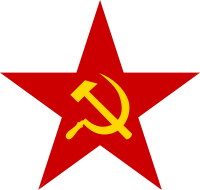Communism in Poland
| Part of a series on |
| Communism |
|---|
 |
|
Concepts
|
|
Internationals |
|
Related topics |
|
|
Communism in Poland can trace its origins to the late 19th century: the Marxist First Proletariat party was founded in 1882. Rosa Luxemburg (1871–1919) of the SDKPiL party and the publicist Stanisław Brzozowski (1878–1911) were important early Polish Marxists.
During the interwar period in the Second Polish Republic, Polish communists formed the Communist Party of Poland (KPP). Most of the KPP leaders and activists perished during Joseph Stalin's Great Purge in the 1930s and the Party was abolished by the Cominterm in 1938.
In 1942 the Polish Workers' Party (PPR), a new Polish communist party, was established in Nazi-occupied Poland and was soon led by Władysław Gomułka. In Moscow the Union of Polish Patriots was set-up with Stalin's support as a rival communist center. As Nazi Germany was being defeated, the Polish communists cooperated with the Soviet Union, in opposition to the Polish government-in-exile, in order to establish a Soviet-dependent Polish state. This led to the creation of the Polish People's Republic and, after the fusion of the PPR with the Polish Socialist Party (PPS), the Polish United Workers' Party (PZPR). In post-World War II Poland, the Polish communists could count on limited popular support and their staying in power depended on the support of their Soviet allies.
There were also repeated attempts by some Polish academics and philosophers, including Leszek Kołakowski, Tadeusz Kotarbiński, Kazimierz Ajdukiewicz and Stanisław Ossowski to develop, as part of the revisionist movement, a form of "Polish Marxism'". While their efforts to create a bridge between Poland's history and the Marxist ideology were mildly successful, especially in comparison to similar attempts in other countries of the Eastern Bloc, they have been stifled by the regime's unwillingness to risk stepping too far in the reformist direction.
In post-1989 democratic Poland, declared communists have had a minimal impact on the political and economical life of the country. However, former communists, including members of the Politburo of the PZPR, remained active on the political scene after the systemic transition and some were democratically elected to top national leadership positions (e.g. Aleksander Kwaśniewski, who was a two-term president of the Polish Republic). Their center-left party, the Democratic Left Alliance (SLD), was one of the major political parties in Poland and was represented in the Polish Sejm (national parliament) until 2015. The influence of the so-called post-communists on the formation of the present democratic Constitution of Poland was essential.
See also
References
- Keith John Lepak, Prelude to Solidarity, Columbia University Press, 1988, ISBN 0-231-06608-2, Google Print, p.19+